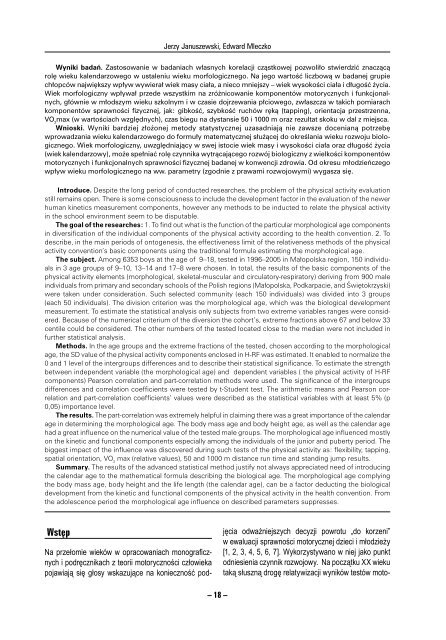full text - Akademia Wychowania Fizycznego w Krakowie
full text - Akademia Wychowania Fizycznego w Krakowie
full text - Akademia Wychowania Fizycznego w Krakowie
- No tags were found...
You also want an ePaper? Increase the reach of your titles
YUMPU automatically turns print PDFs into web optimized ePapers that Google loves.
Jerzy Januszewski, Edward MleczkoWyniki badań. Zastosowanie w badaniach własnych korelacji cząstkowej pozwoliło stwierdzić znaczącąrolę wieku kalendarzowego w ustaleniu wieku morfologicznego. Na jego wartość liczbową w badanej grupiechłopców największy wpływ wywierał wiek masy ciała, a nieco mniejszy – wiek wysokości ciała i długość życia.Wiek morfologiczny wpływał przede wszystkim na zróżnicowanie komponentów motorycznych i funkcjonalnych,głównie w młodszym wieku szkolnym i w czasie dojrzewania płciowego, zwłaszcza w takich pomiarachkomponentów sprawności fizycznej, jak: gibkość, szybkość ruchów ręką (tapping), orientacja przestrzenna,VO 2max (w wartościach względnych), czas biegu na dystansie 50 i 1000 m oraz rezultat skoku w dal z miejsca.Wnioski. Wyniki bardziej złożonej metody statystycznej uzasadniają nie zawsze docenianą potrzebęwprowadzania wieku kalendarzowego do formuły matematycznej służącej do określania wieku rozwoju biologicznego.Wiek morfologiczny, uwzględniający w swej istocie wiek masy i wysokości ciała oraz długość życia(wiek kalendarzowy), może spełniać rolę czynnika wytrącającego rozwój biologiczny z wielkości komponentówmotorycznych i funkcjonalnych sprawności fizycznej badanej w konwencji zdrowia. Od okresu młodzieńczegowpływ wieku morfologicznego na ww. parametry (zgodnie z prawami rozwojowymi) wygasza się.Introduce. Despite the long period of conducted researches, the problem of the physical activity evaluationstill remains open. There is some consciousness to include the development factor in the evaluation of the newerhuman kinetics measurement components, however any methods to be inducted to relate the physical activityin the school environment seem to be disputable.The goal of the researches: 1. To find out what is the function of the particular morphological age componentsin diversification of the individual components of the physical activity according to the health convention. 2. Todescribe, in the main periods of ontogenesis, the effectiveness limit of the relativeness methods of the physicalactivity convention’s basic components using the traditional formula estimating the morphological age.The subject. Among 6353 boys at the age of 9–18, tested in 1996–2005 in Małopolska region, 150 individualsin 3 age groups of 9–10, 13–14 and 17–8 were chosen. In total, the results of the basic components of thephysical activity elements (morphological, skeletal-muscular and circulatory-respiratory) deriving from 900 maleindividuals from primary and secondary schools of the Polish regions (Małopolska, Podkarpacie, and Świętokrzyski)were taken under consideration. Such selected community (each 150 individuals) was divided into 3 groups(each 50 individuals). The division criterion was the morphological age, which was the biological developmentmeasurement. To estimate the statistical analysis only subjects from two extreme variables ranges were considered.Because of the numerical criterium of the diversion the cohort’s, extreme fractions above 67 and below 33centile could be considered. The other numbers of the tested located close to the median were not included infurther statistical analysis.Methods. In the age groups and the extreme fractions of the tested, chosen according to the morphologicalage, the SD value of the physical activity components enclosed in H-RF was estimated. It enabled to normalize the0 and 1 level of the intergroups differences and to describe their statistical significance. To estimate the strengthbetween independent variable (the morphological age) and dependent variables ( the physical activity of H-RFcomponents) Pearson correlation and part-correlation methods were used. The significance of the intergroupsdifferences and correlation coefficients were tested by t-Student test. The arithmetic means and Pearson correlationand part-correlation coefficients’ values were described as the statistical variables with at least 5% (p0,05) importance level.The results. The part-correlation was extremely helpful in claiming there was a great importance of the calendarage in determining the morphological age. The body mass age and body height age, as well as the calendar agehad a great influence on the numerical value of the tested male groups. The morphological age influenced mostlyon the kinetic and functional components especially among the individuals of the junior and puberty period. Thebiggest impact of the influence was discovered during such tests of the physical activity as: flexibility, tapping,spatial orientation, VO 2max (relative values), 50 and 1000 m distance run time and standing jump results.Summary. The results of the advanced statistical method justify not always appreciated need of introducingthe calendar age to the mathematical formula describing the biological age. The morphological age complyingthe body mass age, body height and the life length (the calendar age), can be a factor deducting the biologicaldevelopment from the kinetic and functional components of the physical activity in the health convention. Fromthe adolescence period the morphological age influence on described parameters suppresses.WstępNa przełomie wieków w opracowaniach monograficznychi podręcznikach z teorii motoryczności człowiekapojawiają się głosy wskazujące na konieczność podjęciaodważniejszych decyzji powrotu „do korzeni”w ewaluacji sprawności motorycznej dzieci i młodzieży[1, 2, 3, 4, 5, 6, 7]. Wykorzystywano w niej jako punktodniesienia czynnik rozwojowy. Na początku XX wiekutaką słuszną drogę relatywizacji wyników testów moto-– 18 –





![Antropomotoryka nr 57 [2012]. - Akademia Wychowania Fizycznego ...](https://img.yumpu.com/50213388/1/182x260/antropomotoryka-nr-57-2012-akademia-wychowania-fizycznego-.jpg?quality=85)










